All
Propane Products of Interest
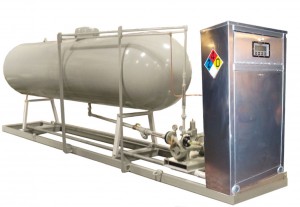
There are thousands of different products and product types that have a place in a fuel marketer’s inventory or product line, and it’s good to know what they are and what they do. Oil & Energy recently checked in with Donald Montroy, Director of Marketing for Bergquist, Inc., to discuss products for the propane marketer. We asked him to identify five products of interest, and he chose the following ones.
Tank Monitoring Systems
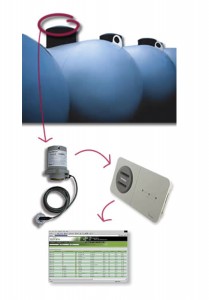 Oil & Energy has reported extensively on tank monitors as tool for improving delivery efficiency and customer service, and Montroy recommends that propane marketers consider using them on select accounts. Bergquist stocks monitors with two communications methods: landline and cellular, and Montroy said the cellular transmission models are “taking off.” They offer ease of setup, because the installer does not have to go inside the customer’s home or business to connect to a landline. Cellular monitors are generally priced higher than landline-based models and lower than satellite versions, he said. To monitor a tank, a dealer needs to buy the monitoring equipment and then pay monthly charges for the transmission services. A typical monitor will transmit a report about 10 times a week, Montroy said, adding, “They are really ideal for accounts that are hard to forecast” such as tanks used for cylinder filling or autogas dispensing or tanks installed at seasonal homes.
Oil & Energy has reported extensively on tank monitors as tool for improving delivery efficiency and customer service, and Montroy recommends that propane marketers consider using them on select accounts. Bergquist stocks monitors with two communications methods: landline and cellular, and Montroy said the cellular transmission models are “taking off.” They offer ease of setup, because the installer does not have to go inside the customer’s home or business to connect to a landline. Cellular monitors are generally priced higher than landline-based models and lower than satellite versions, he said. To monitor a tank, a dealer needs to buy the monitoring equipment and then pay monthly charges for the transmission services. A typical monitor will transmit a report about 10 times a week, Montroy said, adding, “They are really ideal for accounts that are hard to forecast” such as tanks used for cylinder filling or autogas dispensing or tanks installed at seasonal homes.
Flex Risers and Polyethylene Tubing
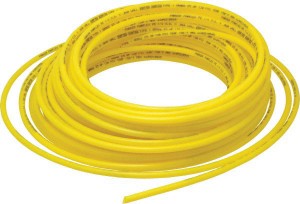
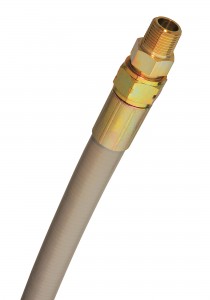 Copper gas lines have often been used to provide the underground connection between a propane tank and the regulator at the home. Montroy recommends that marketers instead use polyethylene gas lines that connect at both ends to risers, which connect directly to the hard piping on the tank and on the house. The polyethylene gas line stands up well underground, and the riser provides toughness where it is needed above ground, to protect the line from sunlight, rodents, weed whackers and other threats, Montroy said. Volatile copper prices have helped to popularize the plastic gas line components, and they are also easier to repair than copper lines, using stab fittings, he noted.
Copper gas lines have often been used to provide the underground connection between a propane tank and the regulator at the home. Montroy recommends that marketers instead use polyethylene gas lines that connect at both ends to risers, which connect directly to the hard piping on the tank and on the house. The polyethylene gas line stands up well underground, and the riser provides toughness where it is needed above ground, to protect the line from sunlight, rodents, weed whackers and other threats, Montroy said. Volatile copper prices have helped to popularize the plastic gas line components, and they are also easier to repair than copper lines, using stab fittings, he noted.
Autogas Dispensers
 Montroy recommends that marketers consider using and selling propane autogas, because it can help improve their allocations while reducing the cost of operating a fleet, either for a customer or for themselves. Some propane marketers are switching their own bobtails to autogas by retrofitting the engines to burn propane. Marketers can also sell autogas to fleets in their areas, such as school buses, taxis and municipal vehicles. There are three different types of dispenser: for company use without vehicle by- vehicle record-keeping; for fleets that track fuel usage by vehicle; and for public dispensing at a filling station. Propane marketers generally install autogas equipment for customers and retain exclusive rights to supply autogas. “It’s an important market,” Montroy said. “There has been a slow but steady increase in the number of autogas gallons sold.” Montroy recommends that marketers look at the size and the differential pressure of the pump when choosing a dispenser type. If the pump is for a school district with multiple buses, you need enough pressure for a robust flow rate, so that fills don’t take too long, he said.
Montroy recommends that marketers consider using and selling propane autogas, because it can help improve their allocations while reducing the cost of operating a fleet, either for a customer or for themselves. Some propane marketers are switching their own bobtails to autogas by retrofitting the engines to burn propane. Marketers can also sell autogas to fleets in their areas, such as school buses, taxis and municipal vehicles. There are three different types of dispenser: for company use without vehicle by- vehicle record-keeping; for fleets that track fuel usage by vehicle; and for public dispensing at a filling station. Propane marketers generally install autogas equipment for customers and retain exclusive rights to supply autogas. “It’s an important market,” Montroy said. “There has been a slow but steady increase in the number of autogas gallons sold.” Montroy recommends that marketers look at the size and the differential pressure of the pump when choosing a dispenser type. If the pump is for a school district with multiple buses, you need enough pressure for a robust flow rate, so that fills don’t take too long, he said.
Cathodic Protection
 Underground storage tanks require cathodic protection to prevent corrosion that can be caused by electrolysis. Protection is generally provided by anode bags, which typically contain a 17-pound bar of magnesium and some earth backfill. In a typical setup, two anode bags are buried with the tank and connected to it by wires. When a copper fuel line is used, installers should also protect the installation with dielectric fittings, which prevent any transfer of electric current from the tank to the regulator, according to Montroy.
Underground storage tanks require cathodic protection to prevent corrosion that can be caused by electrolysis. Protection is generally provided by anode bags, which typically contain a 17-pound bar of magnesium and some earth backfill. In a typical setup, two anode bags are buried with the tank and connected to it by wires. When a copper fuel line is used, installers should also protect the installation with dielectric fittings, which prevent any transfer of electric current from the tank to the regulator, according to Montroy.
Standby Generators
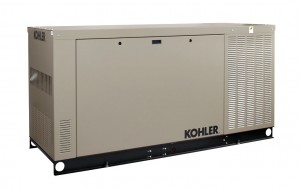 Montroy said there is a robust market for standby generators in the Northeast and Mid-Atlantic regions, due to recent difficulties with major storms, including Hurricane Sandy in 2012, Tropical Storm Irene in 2011 and an epic ice storm in 2008. Propane suppliers have found considerable interest in backup power from their customers, and many suppliers themselves are installing generators so that they can continue operations during a power outage, he said. Bergquist sells generators sized from 8.5kW, which is enough to power some of the functions of a residence, up to 60kW, which is large enough for most commercial applications. Montroy said customers are comfortable buying generators from propane marketers who have the expertise to install and service the units.
Montroy said there is a robust market for standby generators in the Northeast and Mid-Atlantic regions, due to recent difficulties with major storms, including Hurricane Sandy in 2012, Tropical Storm Irene in 2011 and an epic ice storm in 2008. Propane suppliers have found considerable interest in backup power from their customers, and many suppliers themselves are installing generators so that they can continue operations during a power outage, he said. Bergquist sells generators sized from 8.5kW, which is enough to power some of the functions of a residence, up to 60kW, which is large enough for most commercial applications. Montroy said customers are comfortable buying generators from propane marketers who have the expertise to install and service the units.
Related Posts
 How to Set Your Business Apart with Renewable Propane
How to Set Your Business Apart with Renewable Propane
Posted on October 16, 2025
 EIA Report: Biodiesel and Renewable Diesel Imports Fall Sharply
EIA Report: Biodiesel and Renewable Diesel Imports Fall Sharply
Posted on October 16, 2025
 Northeast Liquid Fuel Providers Put Higher Bioblends in Focus
Northeast Liquid Fuel Providers Put Higher Bioblends in Focus
Posted on August 19, 2025
 Lower Carbon Lineup Puts Businesses on the Path to Net Zero Goals
Lower Carbon Lineup Puts Businesses on the Path to Net Zero Goals
Posted on August 18, 2025
Enter your email to receive important news and article updates.
